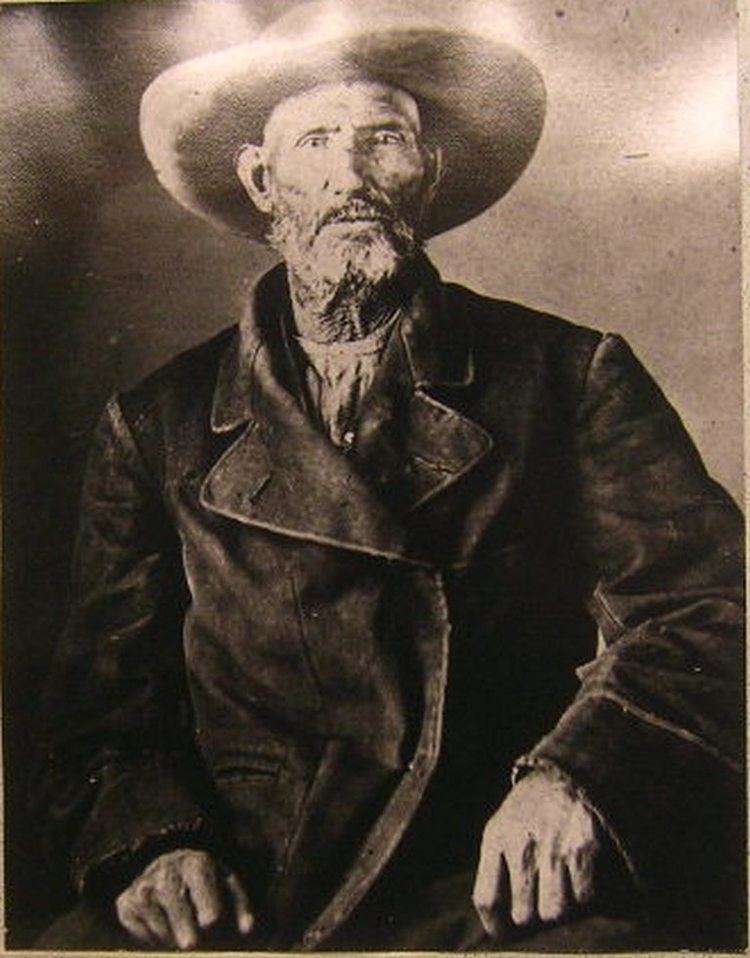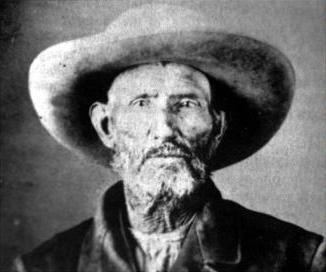Nationality American Books Mountain Man Full name James Felix Bridger | Name Jim Bridger Occupation Frontiersman | |
 | ||
Children Mary Ann Bridger, Josephine Bridger Similar People | ||
The revenant domnhall gleeson andrew henry will poulter jim bridger exclusive interview
James Felix Bridger (March 17, 1804 – July 17, 1881) was among the foremost mountain men, trappers, scouts and guides who explored and trapped the Western United States during the decades of 1820–1850, as well as mediating between native tribes and encroaching whites. He was of English ancestry, and his family had been in North America since the early colonial period.
Contents
- The revenant domnhall gleeson andrew henry will poulter jim bridger exclusive interview
- Jim bridger ji grossmann
- Early life and career
- Hugh Glass ordeal
- Yellowstone and Salt Lake
- Rocky Mountain Fur Company
- Marriages Indian wives and family
- Guide and adviser
- Bridger Pass and Trail
- Death
- Historical reputation and storytelling
- Places and things named for Jim Bridger
- Media portrayals
- References

Jim Bridger had a strong constitution that allowed him to survive the extreme conditions he encountered walking the Rocky Mountains from what would become southern Colorado to the Canada–US border. He had conversational knowledge of French, Spanish and several native languages. He would come to know many of the major European American explorers of the early west, including Kit Carson, George Armstrong Custer, Hugh Glass, John Frémont, Joseph Meek, and John Sutter. Bridger was a young contemporary of British and American pathfinders including Peter Skene Ogden, Jedediah Smith, and William Sublette. In 1830, Smith and his associates sold their fur company to Bridger and his associates naming it the Rocky Mountain Fur Company. Bridger was part of the second generation of mountain men and pathfinders who explored the American West that followed the Lewis and Clark expedition in 1804.

Jim bridger ji grossmann
Early life and career

James Felix Bridger was born on March 17, 1804, in Richmond, Virginia. His father, James Bridger, was an innkeeper in Richmond, and his mother was James' wife Chloe. About 1812 his parents and the young Bridger moved to the vicinity of St. Louis. At the age of 13 Bridger was orphaned when both his parents died. Receiving no formal education, unable to read or write, Bridger was apprenticed to a blacksmith. Bridger remained illiterate for the rest of his life. On March 20, 1822, at the age of 18, Bridger left his apprenticeship having responded to the St. Louis Missouri Republican "want ad" and joined General William Ashley's Upper Missouri Expedition, a party that included Jedediah Smith. Ashley's expedition included fur trapping on the sources of the Missouri River. For the next 20 years Bridger would repeatedly traverse from the Canada–US border and the southern line of the Colorado, from the Missouri River westward to Idaho and Missouri, either as an employee of or partner in the fur trading business.
Hugh Glass ordeal

While continuing his fur trapping venture and employment on the Ashley expedition, the young Bridger played a significant role in the ordeal of Hugh Glass. On June 2, 1823, Ashley's men were attacked by Arikara warriors along the Missouri River. Fifteen men were killed and the rest of the fur trappers fled down the river and hid in shelters until U.S. military support defeated the Arikara. In August 1823, near the forks of the Grand River in present-day Perkins County, South Dakota, while scouting for game for the expedition's larder, Glass surprised a grizzly bear with two cubs. The bear charged, picked him up, and threw him to the ground. Glass shot into the air to scare the bear away and save his trapping partners, but was left badly mauled and unconscious. Ashley asked for two volunteers to stay with Glass until he died and then bury him. Bridger and John Fitzgerald stepped forward, and as the rest of the party moved on, began digging his grave. Later claiming that they were interrupted by attacking Arikara Native Americans, the pair grabbed Glass's rifle, knife, and other equipment, and took flight. Bridger and Fitzgerald later caught up with the party and incorrectly reported to Ashley that Glass had died.
Despite his injuries, Glass regained consciousness. After recovering, Glass set out again to find Fitzgerald and Bridger, motivated either by murderous revenge or the desire to get his weapons back. He eventually found Bridger at the mouth of the Bighorn River, but apparently forgave him because of his youth. Glass later found Fitzgerald and reportedly spared Fitzgerald's life because of the penalty for killing a soldier of the United States Army.
Yellowstone and Salt Lake
Bridger was among the first white men to see the geysers and other natural wonders of the Yellowstone region. In the winter of 1824-1825, Bridger gained fame as the first European American to see the Great Salt Lake (though some now dispute that status in favor of Étienne Provost), which he reached traveling in a bull boat. Due to its saltiness, he believed it to be an arm of the Pacific Ocean.
Rocky Mountain Fur Company
In 1830, Jim Bridger and several other trappers bought out Smith's fur company, who had bought out Ashley, and established the Rocky Mountain Fur Company, competing with the Hudson's Bay Company and John Jacob Astor's American Fur Company for the lucrative beaver pelt trade. In 1843, Bridger and Louis Vasquez built a trading post, later named Fort Bridger, on the west bank of Blacks Fork of the Green River to serve Pioneers on the Oregon Trail.
Marriages, Indian wives, and family
In 1835 he married a woman from the Flathead Indians tribe with whom he had three children. After her death in 1846, he married the daughter of a Shoshone chief, who died in childbirth three years later. In 1850 he married Shoshone Chief Washakie's daughter, with whom he had two more children. Some of his children were sent back east to be educated.
Guide and adviser
Bridger had explored, trapped, hunted and made new trails since 1822. As a guide, Bridger could assess any wagon train or group, their interests in travel, and give them expert advice on any and all aspects of heading West, over any and all trails, and to any destination the party had in mind if the leaders sought his advice. In 1846, the Donner Party came to Fort Bridger and were assured by Bridger and Vasquez that the Hasting's pass ahead was "a fine, level road, with plenty of water and grass, with the exception before stated (a forty mile waterless stretch)." In 1859 Bridger was paid to be the chief guide on the Yellowstone bound Raynolds Expedition, led by William F. Raynolds. Bridger guided the expedition over Union Pass after finding that mountain passes to the north were snow blocked. Though unsuccessful in reaching the Yellowstone Plateau, the expedition explored Jackson Hole and the Teton Range.
Bridger Pass and Trail
In 1850, while exploring in order to find an alternative overland route to the South Pass, he found what would eventually be known as Bridger's Pass, which shortened the Oregon Trail by 61 miles. Bridger Pass would later be the chosen route for both the Union Pacific Railroad and later Interstate 80.
In 1864, he blazed the Bridger Trail, an alternative route from Wyoming to the gold fields of Montana that avoided the dangerous Bozeman Trail. Later, he served as guide and army scout during the first Powder River Expedition against the Sioux and Cheyenne that were blocking the Bozeman Trail (Red Cloud's War). In 1865 he was discharged at Fort Laramie. Suffering from goiter, arthritis, rheumatism and other health problems, he returned to Westport, Missouri, in 1868. He was unsuccessful in collecting back rent from the government for its use of Fort Bridger.
Death
He died on his farm near Kansas City, Missouri, on July 17, 1881, at the age of 77. In the Independence Missouri School District, a junior high and then the middle school which replaced it, are named after the mountain man.
Historical reputation and storytelling
In addition to his explorations, serving as a guide and advisor, Bridger was known for his storytelling. His stories about the geysers at Yellowstone, for example—proved to be true. Others were clearly intended to amuse. Thus, one of Bridger's stories involved a "petrified forest" in which there were "petrified birds" singing "petrified songs" (though he may have seen the petrified trees in the Tower Junction area of what is now Yellowstone National Park). Over the years, Bridger became so associated with the tall-tale form that many stories invented by others were attributed to him.
Supposedly one of Bridger's favorite yarns to weave to greenhorns was about being pursued by one hundred Cheyenne warriors. After being chased for several miles, Bridger found himself at the end of a box canyon, with the Indians bearing down on him. At this point, Bridger would go silent, prompting his listener to ask, "What happened then, Mr. Bridger?" Bridger would then reply, "They killed me." Bridger's tale was similar to the actual death of Jedediah Smith who had died under the lances of Comanche Indians on the Santa Fe Trail in 1831.
Places and things named for Jim Bridger
In addition, Cache Valley in Utah and Idaho is known as "Bridgerland," a name that is used in many Logan, Utah-based businesses and institutions, such as Bridgerland Television and the Bridgerland Applied Technology College. Bridger Avenue in Las Vegas, Nevada is named for him as well. Also the Jim Bridger cabins, a motel in Gardiner, MT, outside the entrance to Yellowstone National Park and the Roosevelt Arch. James Bridger Middle School in Independence, Missouri opened in 1966.
